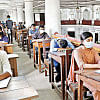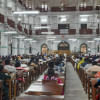India's Deadly Entrance Exams

New Delhi – In late April, a 17-year-old girl named Kriti Tripathi leaped to her death in Kota, India, shortly after passing the country's examination for admission to the prestigious Indian Institutes of Technology (IIT). A week later, another Kota student, Preeti Singh, hanged herself, succumbing to her injuries after a few days. Singh's was the ninth suicide by a student in Kota this year alone, and the 56th in the last five. All attended Kota's "coaching institutes," whose sole purpose is to prepare high-school students for the IIT Joint Entrance Examination (JEE).
In a five-page suicide note, Tripathi expressed her frustration at having been compelled to study engineering, when her real ambition was to become a NASA scientist. She also described the pressure she had faced at the coaching institution. Tripathi implored the Human Resource Development Ministry to shut down such institutes, which force their students to endure unbearable stress and depression. The story is all too common, but should the blame really be laid on the coaching institutes?
In fact, Kota's coaching institutes are a symptom of a larger problem, hinted at by the city's senior administrator, District Collector Ravi Kumar Surpur, in an emotional letter he wrote in response to the latest deaths. Addressing parents directly, Surpur pleaded with them not to subject their children to excessive stress in an attempt to live vicariously through them.
Indian parents are known for demanding academic excellence from their children. They know that a professional degree in the right field is a passport to social and economic advancement, so they push hard to ensure that their children get one – something that India's higher-education system does not make easy. Given this deeply entrenched culture of academic ambition, the planned administrative inquiry into conditions at the Kota coaching institutes is unlikely to result in remedial action.
The toll this culture takes on young people is obvious. Students are forced to pass brutally difficult examinations – only about 10,000 of the 500,000 who take the IIT-JEE each year score high enough to be admitted – in subjects they often detest. And Indian students are far more likely to push themselves until they crack than to drop out.
Engineering and medicine remain the subjects of choice for middle-class Indian parents. The country graduates a half-million engineers every year, some 80 percent of whom end up in jobs that do not require an engineering degree. But, in a throwback to the mid-twentieth century, Indian parents view engineering as the gateway to modernity, and continue pressing their children to study it. Students who do not make it to an IIT end up in institutions of varying quality, many of which do not equip their graduates for today's labour market.
But at least there are enough engineering colleges in India to meet demand. Medicine, by contrast, is a frustratingly crowded field – and for no good reason.
India's medical profession is controlled by the Medical Council of India, an opaque and self-serving cabal that has intentionally limited the supply of available medical college seats. Medical colleges must be recognised by the MCI, which has seen fit to permit only 381 to exist. That leaves only 63,800 slots each year in a country of 1.2 billion people – enough space for fewer than 1 percent of Indian students aspiring to attend medical school.
As if that were not bad enough, some of the seats are awarded against "donations," with the wealthy essentially purchasing positions that their marks do not merit. Meanwhile, high-achieving students who just barely missed the cutoff have to find alternatives – or pursue another field altogether.
Those whose families can afford it often end up studying medicine abroad. Many do not return to India, depriving the country of their much-needed expertise. Some return after having attended obscure colleges in countries like Georgia or China, only to have the MCI refuse to recognise their degrees and block them from practicing. For those who cannot afford to go abroad – even bright students who barely missed the cutoff for a spot at an Indian university – studying medicine is no longer an option.
Yet India desperately needs doctors. According to the World Health Organization, the country has just 0.7 doctors per 1,000 people. In the United States and the United Kingdom – two countries to which Indian doctors often emigrate – the rate is 2.5 per 1,000 and 2.8 per 1,000, respectively. The crippling lack of capacity means that lives are lost every day – particularly in rural areas – for want of medical attention.
India could be graduating four or five times as many capable doctors as it does each year. Yet the MCI has been allowed to pursue its restrictive approach, depriving poor Indians of adequate health care, while augmenting the already-huge pressure on students to gain a seat in a medical college.
It is in this context – with a huge population competing for a tiny number of seats in professional colleges – that coaching institutes like those in Kota thrive. When succeeding in tough entrance examinations is the only way to fulfill one's educational goals, test preparation becomes the be-all and end-all of schooling. Eager to satisfy pushy parents, young people sacrifice their own interests at the altar of a false god. The 56 pyres lit in Kota over the last five years are a tragic testament to how damaging this conception of academic excellence can be.
The writer is a former UN under-secretary-general and former Indian Minister of State for External Affairs and Minister of State for Human Resource Development. He is currently Chairman of the Parliamentary Standing Committee on External Affairs and an MP for the Indian National Congress.
Copyright: Project Syndicate, 2016.
www.project-syndicate.org
(Exclusive to The Daily Star)

 For all latest news, follow The Daily Star's Google News channel.
For all latest news, follow The Daily Star's Google News channel. 





Comments